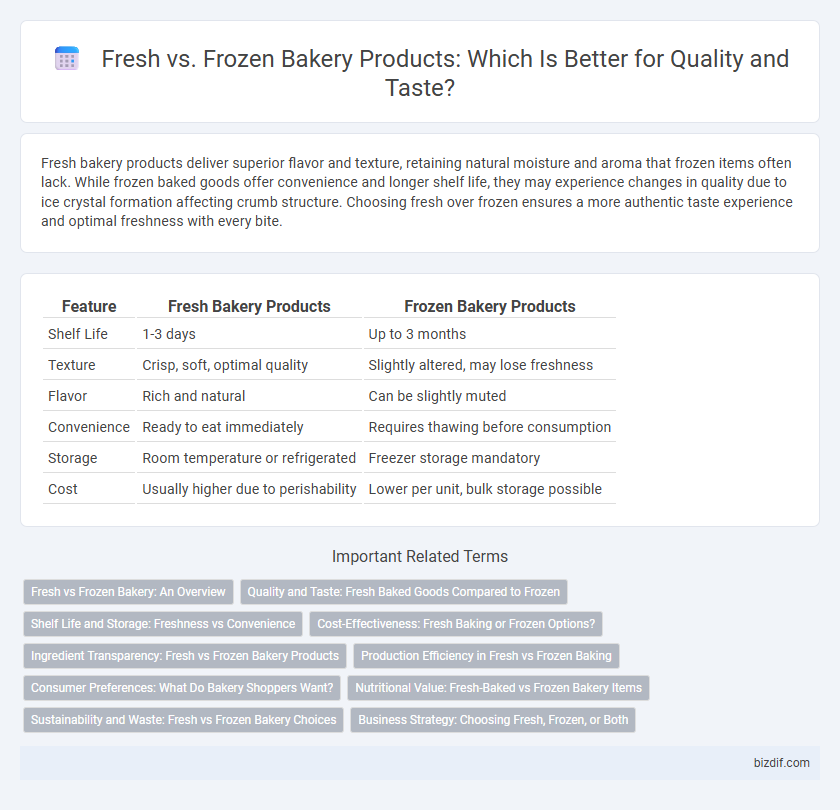Fresh bakery products deliver superior flavor and texture, retaining natural moisture and aroma that frozen items often lack. While frozen baked goods offer convenience and longer shelf life, they may experience changes in quality due to ice crystal formation affecting crumb structure. Choosing fresh over frozen ensures a more authentic taste experience and optimal freshness with every bite.
Table of Comparison
| Feature | Fresh Bakery Products | Frozen Bakery Products |
|---|---|---|
| Shelf Life | 1-3 days | Up to 3 months |
| Texture | Crisp, soft, optimal quality | Slightly altered, may lose freshness |
| Flavor | Rich and natural | Can be slightly muted |
| Convenience | Ready to eat immediately | Requires thawing before consumption |
| Storage | Room temperature or refrigerated | Freezer storage mandatory |
| Cost | Usually higher due to perishability | Lower per unit, bulk storage possible |
Fresh vs Frozen Bakery: An Overview
Fresh bakery products offer superior texture, flavor, and aroma due to their immediate baking and consumption, while frozen bakery items provide extended shelf life and convenience for storage and transportation. Fresh breads, pastries, and cakes contain higher moisture levels and retain natural yeast activity, which enhances softness and taste. Frozen bakery goods rely on freezing technology to preserve freshness but may experience slight changes in texture and flavor upon thawing.
Quality and Taste: Fresh Baked Goods Compared to Frozen
Fresh baked goods often deliver superior taste and texture, with a crisp crust and moist crumb that frozen products struggle to replicate. The quality of ingredients remains intact in fresh items, enhancing natural flavors and aromas often diminished during freezing and reheating. Consumers generally prefer fresh bread, pastries, and cakes for their vibrant appearance and authentic taste experience.
Shelf Life and Storage: Freshness vs Convenience
Fresh bakery products offer superior taste and texture but require immediate consumption within 1-2 days to maintain optimal quality, demanding careful storage at room temperature or refrigeration. Frozen bakery items extend shelf life significantly, preserving freshness for up to 3 months when stored at -18degC, providing convenience without compromising much on flavor. Effective storage methods and timely consumption determine the balance between freshness and convenience in bakery goods.
Cost-Effectiveness: Fresh Baking or Frozen Options?
Fresh baking often incurs higher costs due to daily ingredient use, labor, and shorter shelf life leading to potential waste. Frozen options reduce expenses by allowing bulk production, minimizing spoilage, and extending product availability without compromising safety. Businesses must weigh upfront savings from frozen goods against the premium customers pay for the quality and texture of fresh bakery items.
Ingredient Transparency: Fresh vs Frozen Bakery Products
Ingredient transparency in bakery products reveals distinct differences between fresh and frozen options: fresh bakery items typically use ingredients sourced locally and undergo minimal processing, ensuring higher ingredient clarity and quality. Frozen bakery products often contain preservatives, stabilizers, and additives to maintain texture and flavor during storage, which may obscure ingredient transparency for consumers seeking natural options. Clear labeling and detailed ingredient lists are crucial for both fresh and frozen bakery goods to support informed choices based on ingredient transparency standards.
Production Efficiency in Fresh vs Frozen Baking
Fresh baking demands continuous production cycles, often leading to higher labor costs and time consumption, while frozen baking allows for batch production and efficient inventory management, reducing waste and labor expenses. Frozen dough and pre-baked products streamline supply chains by enabling large-scale preparation during off-peak hours, boosting overall production efficiency. This optimization supports consistent product quality and reduces downtime in bakery operations.
Consumer Preferences: What Do Bakery Shoppers Want?
Bakery shoppers prioritize freshness when choosing products, often preferring fresh over frozen items due to taste, texture, and perceived quality. Surveys show that 68% of consumers associate fresh bakery goods with higher nutritional value and are willing to pay a premium for them. However, convenience and longer shelf life make frozen bakery products appealing to 32% of shoppers who balance freshness with practicality.
Nutritional Value: Fresh-Baked vs Frozen Bakery Items
Fresh-baked bakery items retain higher levels of essential nutrients such as vitamins B and C, antioxidants, and enzymes compared to frozen counterparts. Freezing can cause slight nutrient degradation due to ice crystal formation and cellular damage, reducing overall nutritional value. Consumers seeking maximum freshness and nutritional benefits often prefer fresh bakery products over frozen options.
Sustainability and Waste: Fresh vs Frozen Bakery Choices
Choosing fresh bakery products often leads to higher waste due to shorter shelf life and overproduction, impacting sustainability negatively. Frozen bakery items allow for extended storage, reducing food waste and enabling better inventory management in retail and home settings. Sustainable bakery practices increasingly favor frozen options to minimize spoilage and resource consumption throughout the supply chain.
Business Strategy: Choosing Fresh, Frozen, or Both
Bakeries must analyze customer preferences, supply chain logistics, and cost structures when choosing between fresh, frozen, or hybrid product offerings. Fresh bakery items cater to immediate consumer demand for quality and texture, while frozen products enable extended shelf life and reduced waste, facilitating broader distribution. A dual approach can optimize inventory management, balance pricing strategies, and maximize market reach by combining freshness with convenience.
Fresh vs Frozen Infographic

 bizdif.com
bizdif.com